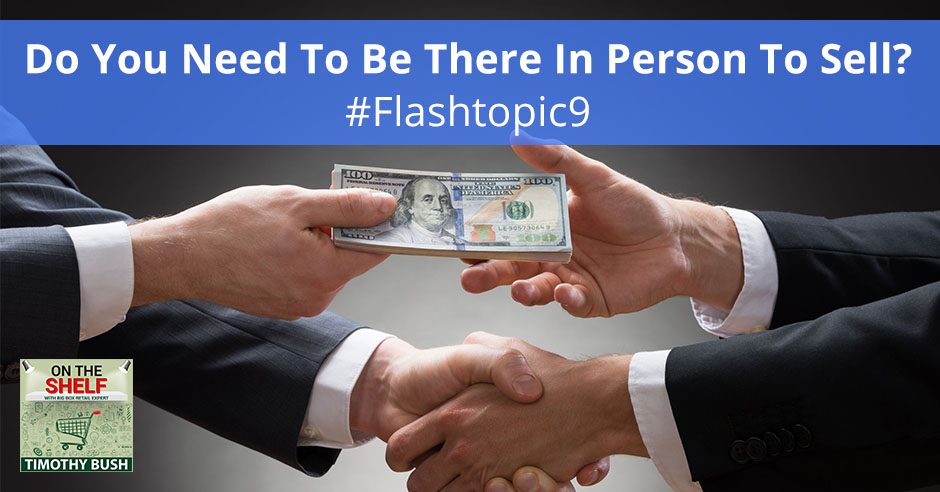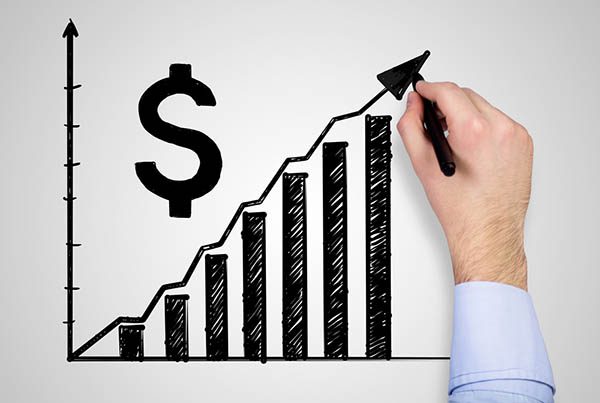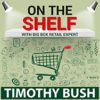
Joe Tarnowski, Tracy and Tom Hazzard, Jamie Robinson from Trivium Consulting, and Salah Khalaf join together in bringing back Flash Topic no. 9 to talk about how selling in person compares to digital mediums. Is virtual selling over the phone, Zoom, Skype, or email just as good as face-to-face? They pour their insights to identify which one is better for sales as they weigh in with each other’s opinions. Tackling the digital types of selling, they discuss about content building, marketing, and using different tools and platforms to reach out to buyers. They top it off with a talk on tariffs, both the good and the bad.
—
Listen to the podcast here:
Do You Need To Be There In Person To Sell? #Flashtopic9
I’m excited that we have Flash Topic back. I know that this is a program that you guys all like. It’s Flash Topic nine. I’m excited to get into it for you. We have a big panel. Joe Tarnowski is back, Tracy Hazzard is back, her husband, Tom Hazzard, is back, Jamie Robinson from Trivium Consulting is back and after a long sabbatical, Salah Khalaf is back. What we’re discussing is all about sales either in person or through digital mediums like Zoom or Skype, which one is better and the attributes of both. Everybody weighs in here and there was a lot of good back and forth as to what people liked and what they didn’t like. Everybody had a good opinion. You’re going to like it. We finish it up with some topics like if tariffs are good or bad. There’ll be some good discussion around that.
—
This is Flash Topic number nine. We get a group of people together and we throw out a topic and nobody knows what it is, except for me because I’m the one who chooses this, which going forward, we should change it up maybe and you guys can pick a topic. I’m a little scared to have Tracy pick a topic. I’m a little nervous to have that because I’m afraid it will be over my head and there was nobody for me to whisper to, “What does she mean?”
We pick a topic, everybody discusses it and then we wrap it up. The great thing about these podcasts is that you get a well-rounded view of the topic. You get experts from every field, from design, to social, to consulting, to content development. We have a lot of people weighing in on what they think about it. It’s a great way if you have this question in your mind or have had it, I would recommend that you go back and start with Flash Topic number one and work your way all the way through those because they’re enlightening. Our topic is something I’ve been thinking about and I just decided to do this, but it’s becoming more and more of an issue. I’m interested in your take. Is virtual selling over Zoom, over the phone, over email and over Skype just as good as being there? Joe, why don’t you go first?
I posted a video about how Amazon, erectile dysfunction and men’s balding are going to boost the adoption of online pharmacy sells.
How does that tie to virtual selling?
If you check on Facebook and on Instagram, you’re going to see a ton of ads everywhere for two companies. One’s called Hymns and the other one’s called Roman. Maybe it’s not directly in sales, but it results in sales of pharmaceutical products but these two online pharmacies, they specialize in erectile dysfunction medicine, since Viagra is now having the generic versions and men’s balding products. The reason why is they go after Millennials because Millennials are a little bit gun shy about bringing that up to people in person. They don’t want to go to their doctor and talk about it or they don’t want to pick up Viagra or balding products from their pharmacist. What they’re doing is they’re having the doctors go online. They have doctors that are registered to prescribe in almost all states if not all states and you go on and the complete prescription process, which essentially is a sales thing, it’s all done through a video chat or regular chat on the platform. Then it’s done as the subscription. They’re seeing a huge growth in sales through those two platforms. The next logical step, if these Millennials are used to ordering those things from there, as they need other chronic ailment medications like high blood pressure medicine, diabetes medicine, that’s the next logical step is for them to find another online pharmacy that sells that same way.
I wanted to clarify, if you want to still tie this in, that’s totally cool. I’m talking about, you personally, us personally. If we want to sell to a buyer or we want to sell anything to anybody with technology the way it is, is it good enough to do it via Zoom or Skype or email or voicemail or is it still better to be there in person? I’m not necessarily talking about corporations selling their product and using digital media. Although that was super interesting.
I’ll let someone else jump in, but we have discussed that at ECRM and trying to implement some of that type of technology. So far, there hasn’t been a justification for it. Salah, what would you think being a former buyer?
Virtual selling is growing. Click To TweetDefinitely, virtual selling is growing. I’ve done it about twice before and it depends. For instance, for Walmart, more and more buyers are putting a disclaimer on the bottom, “You don’t have to fly here. If you can’t make it in person, we can do an online session.” With the advancement of technology and things that are happening, it’s a good thing. I don’t think it’s a bad thing. People are getting used to speaking face-to-face on Skype or Facetime or what have you. With technology now, it has several benefits for buyers and for sellers and we’ll see more of a trend clearly. Those of us like me that I’ve been in business for a while, the face-to-face is more personable. It has advantages, no doubt. It’s more effective. With technology and advancement and high quality and preparedness for the virtual call, then it may be a good thing and that’s my opinion.

What about food? Like your baklava, with a lot of products by seeing it, you can get an idea but with food, without the tasting factor, do you think it’s different with food versus other products?
Definitely. The one time I did it was for food and I’ve sent the samples ahead of time.
That was making me think right here that I haven’t had a face-to-face client in a few years. It’s probably been at least four years, probably since before Vanessa was born. I had a face-to-face client that I would travel to and we would see all the time or we would go on buying trips with. That was furniture and we can’t sell furniture without sitting on it and trying it but pretty much all of the sales I do is pretty much all Zoom right now.
We have the RangeMe platform, which is completely virtual but part of that process involves the buyer requesting a sample. It’s not 100% virtual. It is virtual in the sense that they are not meeting face-to-face during the initial conversations on the platform, but the buyer can request the sample. What I’ve seen that the way it usually happens is they may connect on RangeMe. The buyer will see something they like, requests a sample, they like the sample, they go back and forth. The next step is then a face-to-face meeting. Even with RangeMe, it usually ends up in a face-to-face meeting either at one of our sessions or in the buyer’s office before that sale is made. Even then it’s not completely online.
It depends what type of product or service it is that you’re selling. We have one business that everything we do is virtual and we have customers all over the country. A lot of times we have never met any of them. There have been times where we go to an event and we pick up a client, but the reality is that the client was referred to us by somebody else usually. That referral was going to happen regardless of whether we met them in person or not. I agree with Tracy. With furniture, you’re going to need to sit in it, sit at it. With food, you need to taste it. It’s got to depend a lot on what it is you’re selling.
All the times when I was buying and I was meeting face-to-face, the more you guys are talking, the more I’m thinking how many times I’ve been impacted. The impact was great when I tasted the barbecue sauce right there with a steak, I tried a piece of baklava or I tried a piece of chips that somebody right there in front of me is throwing it to me. At times, I did it virtually with food. It was good too because the samples were right there as well. Face-to-face would still be dominant, but with the trend with technology, that made sense.
Computers will never be as good as face-to-face sales situation. Click To TweetMy first initial reaction to the question was, “No, absolutely not.” Computers will never be as good as a face-to-face sales situation. You can’t get the same warm and fuzzy, you don’t smell, you don’t touch, it’s not the same type of interaction. Even with videos, I don’t feel people are going to get the same interaction as they do in a face-to-face situation. I also agree that it completely depends on what the item is. Definitely, there are some things that require a little bit more than a video or an email or something like that. I’m leading very strongly on the side of there’s no way that a computer interaction is going to be as effective as a face-to-face.
I’m going to have to totally disagree with that and here’s why, because we run a podcast network. We run it and it is video and podcast. The conversion rates are so much higher and faster. That’s what’s been crazy about the virtual selling for us, is that it’s been shocking to me how much of the process is sped up by the fact that you’re not inconveniencing someone, that you’re not trying to wait for that meeting, that you’re not trying to wait until they have time. I was a buyer back at Herman Miller and I would meet with suppliers, they would drain my day. I wouldn’t have the attention span. I’d be exhausted. It would be inconvenient if I had to go to them. You don’t have any of that. If I’m getting my work done, I need to have things done, I can hop on a Zoom and get it accomplished with you quickly. Your energy can still come across. It comes across this microphone that’s why these podcasts do so well. It comes across in Zoom, I get it all the time from my clients. What I get from them is, “You’re exactly the same in person as you are on the phone. You’re exactly the same in person as you are on the computer. That’s amazing.” They do get that. They do think that it’s going to be different, but it’s not.
The speed though I find is the differentiator. We’re all in a hurry. We’re all trying to get our products launched. We’re all trying to get the business close. We’re all trying to get our planograms set, whatever that might be is happening faster. That’s where it will start overtaking it and it has in most businesses. My business is completely different. I couldn’t have done this business ten years ago without doing everything in person and it takes ten times longer. It used to take me nine months to close, now it takes me nine days.
What kind of product or service do you have?
I sell design and development services for products and I also sell podcast production services, so we sell both.
They’re two very different businesses. One is an entirely service-related business. In some respect, they’re both service-related businesses in reality, but one of them is a service-related business to provide product design and development services to companies that are selling hard goods to mass market retail or to Amazon.
Thinking about that it’s like design services. Design in and of itself is a hard thing to sell. It’s a very big intangible like, “Am I going to be any good? They’re going to have to trust me.” If I can get that trust across on a computer and get them to close and do business with me, that’s pretty incredible. That shows you how far the technology has come to being good enough as being in person.

What I was going to say is the benefit in that instance is maybe they’ve done some research before they’ve come onto the meeting with you or maybe they’ve flipped around or they see you, they have some experience. Are we talking about face-to-face meetings that are the first time or something that was you’re traveling across the country, it’s already scheduled and you know that this is going to happen? Even in that instance, these people should be coming with some form of research that they’ve done about whoever they are meeting with and what their abilities of that company are.
Didn’t you do that in person anyway? I would never have agreed to a meeting with a company if I didn’t have a research and background on them already. It should already be happening. The difference is that the content that they might be consuming is my voice and my face because there’s a video. It’s a lot more audiovisual already the research that they can do on me, than a prospectus that I emailed them or that I mailed them. The difference is that they already do feel like they know you. When they get into that first meeting with you, whether it’s virtual or not, they already have a sense that they know they can trust you or they wouldn’t even ask for a meeting.
What’s challenging in retail is a lot of the retailers that we deal with or that I’ve met, they seem to be very relationship-focused. I agree, technology has come a long way and being able to convey the energy, emotions and all that has come a long way. Some industries like retail, whether it’s them being behind enough, they’re still very relationship-focused. It may take longer, but they still want that face-to-face. Salah, are you still seeing that?
I agree. That is the number one focus and number one preference.
Joe, because Tom and I went to visit you at your show when you were here in Anaheim, it’s still a speed factor at the end of the day. I would have totally done that as a buyer because I could have met with everybody all at once. I’ll have them all prequalified. At the end of the day, that’s a speed thing. To me, that’s why that’s working and yes, the face-to-face is good because you can taste it, you can do it all at once, you don’t have to wait for samples to come in. There’s a convenience and speed factor that is still working in your favor there and I would completely do that. It was great, by the way. If you’ve never been to it, you should go.
I was going to say thanks for the plug because that’s essentially why we exist, is to incorporate that combination, that speed factor and efficiency with the face-to-face relationships. That’s what ECRM sessions are all about. Thanks for the plug.
As technology advances, buyers are even trying it more and more to do a virtual selling. After having tried both, especially for food, I may try it for clothing or apparel one day. That may be different where you can send samples, you can send designs and then have a virtual conference call or a video conference. It works both ways. I feel it’s going to grow. I don’t know what that’s going do to how you are noticing that in your business there at ECRM, Joe, with those meetings.
RangeMe is a big part of that, bringing the digital aspect to it. There are discussions but they’re text-based. You have a product, your products are on RangeMe and a buyer is interested. They could reach out to you through messaging function. Think of LinkedIn messaging where you can go back and forth with the buyer but the buyer has to initiate it. Still, you are having a virtual conversation and they can take that all the way through. When they are ready to take that next step and either meet with you in person or give you a purchase order, then it comes offline. It’s no longer on the RangeMe platform. Then they’re going to go off of it to complete the transaction. Yes, in that sense we are bringing virtual sales into the ECRM fold through the RangeMe platform and those functions of connectivity, the ability to order a sample easily from the platform and the ability to engage in a conversation with the suppliers about the particular products in which they’re interested.
Another aspect of why it would be attractive for big corporations like Walmart to encourage their buyers or Target or somebody else is the cost factor. How many times we try to bring buyers to ECRM and how many times they tell us because of costs, we’re not able to make it.
That’s unique to Walmart and a handful of other retailers that you cannot pick up, you can’t host them. There are some retailers where they have to pay their own way and then budget comes into play.
We stopped bringing people over for interviews for instance. I know we’re talking about selling, but that’s another form of selling is an interview where you’re selling yourself as a person to get the job. We’ve done hundreds of those and it works perfectly for interviews. Services that may be much easier than food.
The question was, is it as good as? There’s no question that it’s coming, it’s here, it’s moving forward. I built an entire business for ten years and out of the hundreds of clients I had, I could count on one hand the amount I met face-to-face to get the deal. We happen to be in the same place at the same time. I myself built an entire business virtually around the world, having clients all over the world. I know that it’s possible, I know that it’s coming, I know that it’s here, I know people are using it. When I think about me personally, is it as good as? I don’t think it’s as good as. I never think that talking to a buyer over the phone, on Zoom, on Skype, doing it through email, trading voicemails, I never think that’s as good as being there, being face-to-face, having the undivided attention, being in the room, feeling it.
I’ve had a lot of different voice conversations go south because I can’t see what they’re looking at. I can’t watch them roll their eyes. I can’t see if there are other people in the room. I was talking to somebody once on Zoom and it was halfway through the conversation before I figured out there were two other people in the room. They were listening in. I can’t be there. For me personally, I’m much better and not that I’m not amazing over Zoom or Skype, but I always feel like I’m much better face-to-face when I can.
Just to clarify, what I was talking about throughout this conversation is mainly a video conference, not a conference call where you can see in the room, you can see what’s around.
When I was talking digitally, I’m talking about all forms of digital, whether it’s email or voicemail. I would rather have a Zoom conversation with the buyer than have a conference call. I’d rather have a conference call than trade voicemails. I’d rather trade voicemails than trade emails. All of these tiers stepped up. My ultimate goal is always if possible to meet that person face-to-face, shake their hand, understand a little bit about them and have a conversation. The one thing with Zoom and Skype which Tracy was mentioning, is a benefit and can also be a detriment. Generally, they’re shorter. They’re getting squeezed in, they’re in their office. Other things are affecting them, emails are coming in on their computer, their phone is ringing, all those things still exist and those distractions still exist.
What I was thinking about was, is it better? I know it’s coming and sometimes I liked these. I was at GMDC when they were starting to implement. GMDC, they do a much lesser job of what ECRM does on a much smaller scale. They were starting to implement video and you could sign up and bust out ten buyers in one day sitting at your desk. I don’t think that it panned out well. I don’t think that it worked as well.
That definition is what’s better. Is it more sales? Is it more conversions? What is your definition of better? I agree with you. I love relationship building. I am a people person that’s why when Joe was in town, I went to go see him. That’s why Tim, when I was in Orlando, I went to go see you. That’s why we do that because I’d love to have that face-to-face and get to know on a deeper level who we’re working with. It’s speed and dollars. Because of speed, virtual selling has been very successful for us and I can’t argue with the numbers.
Not only is it virtual selling directly one-on-one with someone but for us, it’s virtual selling of all of the online content we’re creating that’s selling for us all the time even when we’re not doing it. We have customers finding us because of content we’re putting out there, whether it’s on our website, on social media or podcasts. People are finding us. It’s casting a much wider net to market us than we could ever do one-on-one, making phone calls ourselves and sending emails ourselves. The technology is changing the dynamic and the playing field tremendously. I agree there will always be value in face-to-face meetings, but if all we had to do was rely on those, if the modern internet didn’t exist and these technologies didn’t exist, I would not be able to build a business as quickly and organically as I have with both of our businesses. It wouldn’t even exist because of it.

You bring up a great point and an important one that may separate you guys from the average person trying to sell virtually. That is the fact that you put so much great content out there that is doing the work for you so that it’s almost in effect acting as a multiplier so that it does make it easier for someone to trust you when you do have that virtual meeting. Imagine trying to do your sales without having all of that content that you already have out there. It might be a little tougher, but you already have that trust with them because that’s one big thing, that trust factor of building the trust. Because you’re consistently steadily putting out this content, they are going into this virtual meeting with you knowing that they can trust that you guys know what you’re doing. I don’t think it’s the same for other people that do not put out that much content.
Joe, you must be finding that too.
When I was buying, I had a salad dressing that was regionally relevant for New Jersey and the New York area back in the day. It was an email, then a conference call, samples were sent to the office and I placed it in the northeast area without even seeing the supplier. Sometimes if you have a good feel as a buyer, if you had a good feeling about the product, it is regionally relevant, you have facts in front of you that tells you this is already proven to be good, then virtual selling or the virtual way works. People are trying this salad dressing, what is the taste of it, what have they proven in that area? It’s selling, it’s an own brand. For me, why should the buyer fly in and then look at this while it’s already in the market and selling in other areas? I’ve done that before, it just came to my mind.
In marketing, the content is so much more valuable than anything else. Click To TweetThe other thing about the content thing, we have this client a couple of years ago who came to us. I was talking to him. We’re having this great conversation about what we can do, the services, what his product is and the whole thing. We’re having this amazing conversation and I say, “On our website, we have this, this and this.” He goes, “What’s your website?” I said, “We’ve had this whole conversation, you’ve contracted us already.” He basically already signed and we were having our intake and he has never seen my website because he had seen all the content that was out there. He had already seen videos and blog posts and read articles. He never went to the website, so he didn’t see the services, packages or anything. Not that we have that up there, but none of our portfolio. I found that to be shocking to me and it was eye-opening at that point. That was the tipping point for me, that the content was so much more valuable than anything else that we did.
I would argue though that that’s marketing and not necessarily sales.
That’s valid.
The whole purpose of marketing is it’s almost like presale. My goal of creating content is to do some of the sales jobs for us at ECRM.
Marketing supports the sales staff Click To TweetI’ve always presented it as marketing supports the sales itself.
I never isolate this. I have somebody who wrote and I had to share it with you, Tim, because you’re going to want to share this with the audience. I wrote this fabulous article that was a back and forth between design and marketing. It was like a love letter to marketing about how they were having a debate and a dissension among each other about who was more important. I feel that same way about sales, marketing and design, is I treat them holistically like they’re one big thing together. For a lot of us who have small businesses, it is one big thing because we’re doing it all. To not thinking of it as doing all the heavy lifting altogether, that’s a mistake. It’s when we get bad design. In my mind, if the design isn’t supporting sales and isn’t supporting an easier way to market it, then you’re not doing your job in design. If marketing isn’t marketing the unique features and supporting what the sales goals are, then you’re not doing good marketing. I always look at them from all those perspectives at all times and want them to do one thing. I don’t like the isolation of any one of those things.

Tim, back to your comments about it could be an email, it could be anything. What we’re all saying here is it’s the combination of virtual and in person may be the best way. It starts with an email, it goes to a conference call, then it advances, it could be to a face-to-face. It’s not going to be virtual all the way, it’s not going to be maybe person to person all the way, but a combination would be ideal.
I’m always pushing towards something. For instance, when I was working with potential clients, my goal was to get them on the phone. It’s not necessarily a Skype call. For me, clients are better on the phone. With buyers, I’m always pushing them for a face-to-face meeting if I can get that in. I was wondering earlier I was brainstorming and thinking, is that where I should be pushing these people to?
Tim, doesn’t this whole question also depends greatly on the context of who you’re selling to? Most of what we’ve been talking about here are sales to brick and mortar retail chains. I know this is On the Shelf in reality, your show and everything, but can we ignore the absolute dominance of Amazon? There are so many companies selling on their platform on their own being third party sellers, but then Amazon continues to take away more and more business buying and reselling products as a big retailer does. Very few of the companies even selling in that context where Amazon buys the product from you, it’s not under the consignment model like most third party sellers do. They’re buying it and reselling it for whatever price they want. Not only as a consumer never touching it or seeing it before they buy it but in many cases, the buyer of the product is not either.
That’s a whole other podcast. That’s a podcast that I would love to go through. I still remember when I used to visit the Amazon offices and they were one building in Downtown Seattle and now the entire block is all Amazon. Back then you could only sell to Amazon and you’d have to go there and they did see it and you pitch it like any other retailer. You’re right, I don’t even think they care what the product is, they’ll just bring it on. They have the warehouse space, they have everything, they’ll bring it in and if it doesn’t sell, they’ll mark it down until it does and then be done with it.
A combination of virtual and in person sales may be the best way. Click To TweetHave you done that with any of your clients? Have you met any of the retail buyers? Tom’s sister was one for a while and she never met any of her vendors.
Years ago when there wasn’t Seller Central. Nowadays, once the buyer agrees to bring you on now, you don’t ever talk to that buyer ever again. You’re now in the system and you talk to data people that keep the process running, but you never have contact. That buyer is now onto the next person.
That may work for Amazon, but it may not work for On the Shelf retailer.
I’ll ask you guys each. I’ll start off and say if I had my preference, I would prefer to meet people face-to-face. With that said, I built an entire business on the exact opposite of that. What prompted the question for me was, should I even be pressing for face-to-face meetings with buyers anymore, or should I be pressing them for a virtual meeting, a Skype meeting or a Zoom meeting? Maybe change that up a bit. That’s why I was wondering if it’s as good.
If I had my preference, I would do it face-to-face. You all know me, I love technology and I’m on board for things progressing and I’m interested and excited to see them progress but I don’t think it will ever be the same. We had some family over during the summer and one of my nieces was texting with her boyfriend and I said, “You’ve been texting for the last 40 minutes, why don’t you call him?” She said to me, “Then I would have to answer his questions on the spot.” It dawned on me that kids now, they might be doing that with two or three people at the same time and thinking about what they’re going to answer, what they’re not going to answer. Heaven forbid, you should get on the phone and have a real-time conversation that you do have to answer something right on the spot. What would that be? I thought about that answer for a long time and it disturbed me a little bit because that’s what’s coming.
I still enjoy the face-to-face and that’s one of the things I love about ECRM because not in the meetings, the face-to-face at the breakfast, lunch and dinner time that you don’t get to have with buyers generally. For me, I’m going to say yes, I’d prefer to do face-to-face, but I’m up for how technology takes it in. Just like you, Tom and Tracy said, I would’ve never been able to build TLB Consulting if I had to meet everybody face-to-face. It would’ve never happened. It would’ve been an impossibility. Joe, when it all comes down to it, what would you rather?
I always prefer face-to-face. I’m a face-to-face guy. I love people. ECRM makes it easier and more efficient. I do see the potential of virtual, but I personally am a face-to-face guy. I will always like being in the same room or outside but meeting face-to-face with a living, breathing human being.
Salah, what would you rather?
Definitely face-to-face but going with the trend and what’s going on with technology and the younger people and all that. I’m open but definitely face-to-face makes it that more personable, more effective, especially ideally where there is more of a product for sale, not services.
Jamie, what would you rather?
I want to preface this by saying that I am not a salesperson. In fact, that’s one of the areas that I’m least comfortable with if you will, but I have supported salespeople my entire career. Personally, face-to-face is where it’s at. That’s certainly my preference.
Tom, what would you rather?
I’d rather be virtual. Part of that is we’ve already discussed and I won’t reiterate why I feel that is, but there’s another aspect to this for me is that personally, I present better and I’m more likable to people personally because of me and my skillset talking on the phone or being on a video. I come off better that way than I do in person and I’m more effective as a salesperson that way. That’s unique to certain kinds of salespeople.
The other thing I want to throw into this is I remember, I was going around the country on sales calls for buyers for large national retail chains. I remember one buyer in particular from Office Depot that even when you have a scheduled meeting off-site, out of their office and you’re displaying a bunch of products, you have supposedly “undivided attention,” three quarters of the time he’s sitting there going through his emails on his Blackberry and trying to have you believe he’s paying attention and listening to what you’re doing. I don’t necessarily think because you’re there in person, you have their undivided attention.

A couple things you said, I agree with. I wasn’t thinking about that. For the longest time, I didn’t put my picture on LinkedIn or for forever because I’m a big believer that people can make a judgment about you based on your picture before they even get a chance to talk to you. It’s incredibly insightful that you know where you come across better and that makes a tremendous amount of sense to me. Believe me, I flew across the country to go see a guy and he made the appointment on Valentine’s Day. He made me sit in the lobby for two hours. Face-to-face isn’t always warm and fuzzy, I’m with you on that and I appreciate your insight. Tracy, what would you rather?
At this stage of my life with two young kids at home, virtual is the way to go because I want to have a life, I want to have my family and I want to have time with my girls at night. I was doing the on the road thing for a long time and that’s a big strain on you and your family and everything. The virtual convenience of it is outstanding. That being said, I love in person. I would do anything to be able to do that, to be able to have constant in-person giving speeches in events and meeting people in person. I love it. Can I stop selling and maybe do that? That may be my future, so we’ll see.
Maybe sooner than later we’ll put this Flash Topic on Zoom where everybody can be on it and then we’ll put it on the YouTube channel. That would mean that I would have to take a shower.
Tim, it’s funny you mentioned Zoom. The RangeMe folks, when we first acquired them, they are big on doing video conference calls and we don’t do that. We’ll do a phone call, it’s a regular phone call or communication with someone I know. I prefer a phone call. Let’s say you’ve got to show a desktop or some slides or something, then it’s invaluable but if it’s a conversation with someone you know and it’s not adding any value, I prefer a voice call because I got tired of adjusting my head to fit in the screen and resisting.
I agree with you, Joe. If we’re going to chat, I don’t need to see you. Interestingly enough, I was standing in line at the grocery store and the person in front of me was FaceTiming. Two things about it bothered me. One is why do you need to FaceTime? All around the grocery store, they’re FaceTiming. In line, I’m in the frame of their FaceTime. I was like, “Just talk on the phone.” I was texting with my best friend from high school and out of nowhere, he hit FaceTime and then we started talking. What a great time we had because I hadn’t seen him in years. To turn on the FaceTime and see each other face-to-face, both of those were cool, but I did get tired after a while holding my phone. Finally, I had to tell him, “I’m tired of looking up your nose.” Let me ask you one last question. I’m interested in your take on good or bad on tariffs.
The company JOANN’s came out with a big email campaign to all of their membership saying, “We’re giving you a heads up that this is going to affect our prices going forward, which means it’s going to affect the Girl Scouts. It’s going affect the church groups, it’s going to affect all of these things.” I wrote an article about the trickle-down of that. One of the things that a lot of people aren’t seeing, and I don’t know if you guys are seeing it as well, is we’re getting a lot of feedback from factories and from brands and other things that the purchases for fourth quarter are down. That means that inventory will be down. That means there will not be as much on the shelf in the fourth quarter as we expect to be for our holiday sales.
While our economy seems to be robust and there could be a lot of buying happening in the fourth quarter, we could’ve had a banner quarter for many of us in our brand, we may not see the sales we expect because there’s not enough inventory to support that. We had that happen a couple of times before in the last decade. It has a tremendously negative effect on the overall economy, beginning of the following year. That’s where we’re seeing purchases down and the amount of purchases, the amount of inventory being purchased and shipped at this time of year is low compared to prior years.
Against tariffs for you?
I am. Don’t get me wrong. Adjustments need to happen, but I don’t know that this is the way to do it without the definition of what exactly is being terrified. It’s too much conjecture. It’s making everybody nervous and if they’re nervous, they don’t buy as much. They panic.
Who’s going to speak up next?
I was going to say I’m against. We had an aluminum foil that’s got to be imported from outside at 30% lower cost. It’s also not just cost, there wasn’t enough to be manufactured within the US for aluminum foil to supply enough for the demand. We scrapped a deal and we’re still trying to get an exclusion, but it’s ridiculous how much it’s going to raise the cost. I’m with Tracy there, it’s not right and I’m against.
Salah, how will that affect you for the next three to six months?
In the aluminum foil, it’s going to affect because we can’t import, we can’t bring it. To buy it here, there’s not enough, that’s the number one reason, and the cost is 30% higher.
It goes ahead and underscores exactly what Tracy said.
Are you saying that you can’t import it or when you import it, the cost is too high?
I can import it, but it’s going to be 30% higher.
We know how much buyers love to raise their prices.

It’s already happened in aluminum foil. I don’t know if you guys noticed.
Tom, what do you think?
I am very much not in favor of tariffs. We deal with a big cross-section of categories of product and of industries of both manufacturer and materials. Across the board, I see that raising tariffs does not create more jobs in the US. Even though it may create some jobs or benefit some companies in the US, overall for our economy, it is hurting more jobs and taking away more jobs and more opportunity for American businesses than it is helping. I’ve also seen specifically take an example, the bedroom industry. There have been tariffs on importing bedroom furniture into the United States from China in particular for more than a decade, maybe even as much as fifteen years. It did not do anything to bolster the US furniture manufacturing industry the way it was intended. In fact, continued to hurt it because there were many more US companies importing bedroom furniture from China than we’re making in US.
What did all those companies do when they could no longer import? This is in particular solid wood bedroom furniture from China. They went to Vietnam, they went to Indonesia, they went to other countries to do it to avoid the tariff and the US companies did not benefit. There are a number of perspectives I have. Definitely, I don’t see tariffs being good for the US economy.
I agree across the board with a caveat. The way it’s put out there, it’s pretty confusing what’s getting tariff, what’s not getting tariff. I have a client right now that the cost of their brand-new product that they haven’t even brought across yet went up $9 because of the tariffs. Tom, your point is interesting and sad at the same time that putting up tariffs and making it more expensive to import products don’t have a correlating effect in the US. Maybe what that means is that you have to put tariffs up across the board before it makes sense for the US industry to take hold. It also means to me that there are people out there that aren’t seeing the benefit and aren’t taking advantage of it. I’m concerned about it. I’m forward in the right way. I’m concerned that we’re stuck in this, everything has to be $9.99.
We need some price increase.
I remember this vividly when the economic downturn happened and I was telling this to my wife. We were in Vegas at the time, we were walking through the mall. There was Ann Taylor, which at the time was this high-end retailer. They had a sign out front that said, “50% off everything.” We couldn’t believe it, “What do you mean Ann Taylor 50% off everything?” Years ago, I took this electric toothbrush to Bed, Bath & Beyond and it had this unbelievable sonic motor in it. It was top of the line and it was selling for $99 and they want it to retail it for $39.99. I knew that we need a collective understanding in this country that it does cost money to manufacture quality goods.
One of the retailers that’s doing good at this right now is REI. They don’t discount everything. There’s no 40% off everything in REI. They’re doing well because they’re selling quality products that are going to be around for a long time. They’re selling them for a price that is good for it. I’m not in favor of how it’s done, I feel like we’re trying to shove it in there. I do think that there needs to be some equality in the importing of products into the US, as there is when we try to export into any country, we’re hit with huge taxes and it makes it difficult to export into Brazil and North America and some of those countries. Coming back here, there’s nothing, you can freely import. I do think there needs to be some reconciliation there.
One of the other factors that are thrown in here that I’ve experienced with pricing new products over in China is that there has been an advantage happening lately. For many years, the Chinese currency was appreciating against the dollar. You were talking about everything can’t be like $99. Even the price points, you have this magic price points that are for certain products that if you go over it on retail, it’s taboo. It’s like, “I can’t go over that. I won’t sell as much as I did last year.” Every buyer at every store needs to do at least as well as the previous buyer did or the sales were last year or else their jobs’ in jeopardy. They don’t want to go north of these magic price point. In our case of a chair we sold at Costco, that’s $99 retail.
It’s been $99 for seven years.
Believe me, at the beginning of that seven years, the currency was a little more in our favor and it changed over the years as Chinese currency appreciated and you get squeezed on your margin. Now we are at this point where the dollar is getting stronger against the RMB in China and there’s a little more room for margin, for profits or for making a better-quality product at the same price and now the tariffs are coming in and eclipsing that value or having an opposite effect to what that could be having in our economy.
What Tom’s pointing out is what usually happens is that when this happens and you go into this and you’ve got to adjust. With aluminum foil, it’s difficult because you’re talking about a commodity product that is like, “It is what it is.” It’s material. When you’re talking about the chair or something like that, the only thing that happens is they go, “It’s 30% more, find a way to cut 30% out of this design.” That’s where Tom and I come back in and we have to figure out how not to destroy the quality of our product but reduce its cost by that much. It’s a scary venture. For the consumers, at the end of the day, they are not getting as good a product and they’re still paying the same price. It happens all the time. You deal with it every day, Tim.
I’m not an economist so I don’t know what the exact answer is, but I’m glad for all of your insight. Joe, did you have anything to add?
I was thinking when you were talking about being afraid to charge pricing and then you have someone like Apple, they’re charging $1,000 and change for their new phone and people are paying.
$400 for the ugly watch.
The thing is because they can, they ask for it. They’ve gotten their consumer used to it. It’s going to be an expensive phone, but I’ll buy it. I usually stay one version or two versions behind. The other thing is the 6s that I had, I used the hell out of it. I beat the hell out in that phone. I use it to record, edit and upload all my videos when I’m on the road and that thing never ever gave me any problems. You’ve got the quality there too so they can ask for those prices and that’s going to protect them a little bit because people are used to it.
What will happen if the US government, like the rhetoric he is talking about coming out of the current administration in Washington, if they put a tariff on that type of product coming out of China on those smartphone electronics, trying to get them to manufacture it in the United States? It’s not going to happen. No way.
Either they’ll reduce the quality value, the value you’re getting at the end of the day or they will raise the price on you.

Give me one thing, each of you, that your business is doing that’s brand new or that’s coming up. Hazz Design, what do you have that’s new and innovative that’s coming up? We’ll leave it there.
You’re now going to laugh about onsite strategy days.
That takes credibility for everything you said.
We do onsite strategy days but it’s mainly because they need to involve an entire team at a company. It’s not because of not doing virtually. They’re already our clients, but we’ll do an onsite strategy day to cut, clean and create their product line because they have too many skews. We go in and we’d do that in a day.
Our other business, which is the podcast business, we are developing a physical product, it doesn’t exist on the market. The microphone was a unique feature for recording things like this. You guys will love it for every recording on location somewhere without all the additional equipment. That’s the big thing that’s been developed and is in the preproduction process right now.
I can’t wait to see that. I have to tell you after you helped me out with my Zoom, Tom, that’s all I use now even when I’m at home because I can tell the difference when you produce the podcast. I can tell the difference in the quality from the Zoom product to my other microphone.
If you could do it in person, quality is going to be better. Click To TweetAny offline digital audio recorder is going to do a better job than if you’re recording someone remotely. If you could do it in person, quality is always going to be better.
Salah, what’s going on with your company? What are you doing?
I’m a product for resale, we’re introduced to Walmart. Walmart is all about low cost. We’re selling them low cost but made in Italy optical eyewear. We’re venturing into a different line of work. It’s nothing innovative but we’re trying to give them value because it’s all about costs, but we want to get them out of this low-quality stuff.
Joe?
RangeMe just launched industry insights for the suppliers that are on the platform. In other words, they will be able to dig into metrics on buyer behavior on the platform. They’ll be able to tell what categories are getting the most buyer activity, which certifications of products, which ingredients. There’s a whole bunch of ways they can slice and dice it, but essentially they’re going to get a sense of what is top of mind among the buyers on the platform.
Jamie, what’s going on at Trivium Consulting? What’s new?
It’s new to us. It might not be innovative, but we spent a lot of time doing these types of things for our clients and now we are developing our own passive income, if you will, for the business and developing a DIY marketing program for people to come and get workbooks or worksheets or templates or whatever that they need from our website so that we don’t have to hold their hand and walk them through it. There are people out there that I’ve met that seem to prefer to do it themselves. Why not let them?
We here at On the Shelf podcast, I scheduled my very first Facebook Live event. It’s on the website. You can go check it out it’s under upcoming. It’s under What’s Up Next. We’ll be doing a monthly Facebook Live where you can come and listen to a topic and then ask questions and be live. What will follow that is the introduction of our new YouTube channel, which we will be posting on the YouTube channel along with some other things. I’m pretty excited about that.
Everybody, great conversation, super appreciate all of your time. As always, great information, great insight, great back and forth, I appreciate all of you. Thanks for being on Flash Topic number nine. I look forward to talking to each of you very soon.
—
Flash Topic Number Nine is in the books and it was a good one. I know that we jumped around quite a bit, but that’s okay because it was a discussion and it was passionate. I hope you were able to form an opinion on how you want to move forward with digital types of selling, whether it’s content building, marketing or using tools like Skype and Zoom to reach out to buyers. We had some discussion on tariffs, good or bad. I’m sure you have your own opinions there and the panel was able to break that down a bit. Many thanks to Joe, Tracy, Tom, Jamie and Salah. Great insight, everyone. Thanks so much for joining Flash Topic number nine.
People that are doing this every single day have built businesses from scratch. Click To TweetAs for Big Boxers out there, this is a place for you to get some key information, some good insight from leaders in the community. People that are doing this every single day have built businesses from scratch. I encourage you to check out each one of the businesses of the people that are on the panel so that you can get more familiar with what they do and how they do it. They’re all excellent in their field. We have some news, we have something cool. Our first Facebook Live event is coming up. You can see it on the What’s Up Next section on the website. There’s a link to our Facebook page. We have a Facebook page and I would encourage you to all go and hit like. It’s basically Facebook.com/OnTheShelfNow. That will help notify you that the Facebook Live events are coming.
We’re going to try to do a Facebook Live event every single month. We’re going to hit a topic. This coming topic for the event is factoring program cost into your pricing model. If you price products, if you have products for sale and you want to talk about those, or you want to learn about factoring the program cost into that model, that’s the place to be. We’re going to talk and have a discussion briefly and then we’re going to open it up to questions. It will be live, that’s what Facebook Live is. I’m looking forward to touching base and talking to you all via that medium. Those recordings will go up on our new YouTube channel. Excited to get that up and running.
There’s so much stuff happening for On the Shelf. We have a website. We have a Twitter account, @OnTheShelfNow. If you have a Twitter account, please go to On the Shelf Now and follow our Twitter feed. We have a Facebook page, @OnTheShelfNow. We still have our closed Facebook group, On the Shelf Now. Big happenings at the podcast and I’m glad that you are all part of it. Now that we’ve talked about our Facebook Live event, I want to tell you that topic wise and question wise, we want you guys to write in. If you go to the What’s Up Next section of our webpage, there’s a place for you to click on and upload questions, comments, topics that you want us to talk about. If you have a Flash Topic topic, that’s the place to put that. We want to hear from you, we want to hear what you’re thinking, how you’re liking the different podcasts that we’re putting out and get some discussion going. Only through back and forth with other likeminded people are we going to take this to the next level so that you can get as much information and have as much information as you possibly can.
If you’re liking the podcast, please go and check us out on Twitter, check us out on Facebook. Go to OnTheShelfNow.com and comment on the latest podcast and give us some insight. Send us some topics or questions that you want us to cover. We appreciate it. I’m looking forward to speaking with you again, looking forward to the next podcast but until then, I look forward to seeing your products On the Shelf.
Important Links:
- Joe Tarnowski
- Tracy Hazzard
- Tom Hazzard
- Trivium Consulting
- Salah Khalaf
- RangeMe
- ECRM
- Tracy Hazzard’s article
- Hazz Design
- What’s Up Next
- Facebook.com/OnTheShelfNow
- @OnTheShelfNow on Twitter
- @OnTheShelfNow on Facebook
About Joe Tarnowski
 Dynamic and innovative content development expert with a proven ability to find information needs within any industry and engineer a solution to meet those needs via the most relevant media – whether it’s print, online, or face-to-face.
Dynamic and innovative content development expert with a proven ability to find information needs within any industry and engineer a solution to meet those needs via the most relevant media – whether it’s print, online, or face-to-face.
Skilled and experienced in both editorial and sales in the B2B publishing arena, with excellent presentation skills – whether one on one, a small group, or addressing a large audience at an industry event.
Adept in creating partnerships among industry members with complementary strategies.
Specialties: Custom content development, business development, writing, editing, developing trade show content, public speaking and presentations, social media, webcasts
About Tracy & Tom Hazzard
 As a Brand and Product Strategist for Hazz Design, Tracy Hazzard has ghost-designed, sourced and launched 250+ consumer products generating more than $2 Billion at e-commerce and mass-market retailers. For over 25 years, she has worked with design-leading brands like, Martha Stewart Living and Herman Miller to out-design, out-source and out-profit the competition. Tracy is the co-inventor of 37 patents that have helped her clients get acquired and achieve high asset valuations. In addition to being an Innovation Columnist for Inc., she has been featured in Harvard Business Review, Forbes, Wired and CNN Money. Tracy co-hosts the podcasts: Product Launch Hazzards, Feed Your Brand and WTFFF?! 3D Printing: the 3D Start Point for disruptive technology.
As a Brand and Product Strategist for Hazz Design, Tracy Hazzard has ghost-designed, sourced and launched 250+ consumer products generating more than $2 Billion at e-commerce and mass-market retailers. For over 25 years, she has worked with design-leading brands like, Martha Stewart Living and Herman Miller to out-design, out-source and out-profit the competition. Tracy is the co-inventor of 37 patents that have helped her clients get acquired and achieve high asset valuations. In addition to being an Innovation Columnist for Inc., she has been featured in Harvard Business Review, Forbes, Wired and CNN Money. Tracy co-hosts the podcasts: Product Launch Hazzards, Feed Your Brand and WTFFF?! 3D Printing: the 3D Start Point for disruptive technology.
An inventor with 37 patents and an unprecedented 86% success rate for consumer product designs, Tom Hazzard has been rethinking brand innovation to design in success for over 25 years. Tom’s patented innovations provide entrepreneurs and businesses of all sizes a system to spread their brand, grow valuable consumers, and diversify into higher converting revenue streams without a lot of time, cost or effort. Tom is co-host of the Forbes-featured fast growth WTFFF?! 3D Printing podcast as well as host of two new podcasts, Feed Your Brand & Product Launch Hazzards borne out of his core business, Hazz Design, where he has designed and developed over 250 products that generate $2 Billion in revenue for retail and e-commerce clients.
About Jamie Robinson
 Creating opportunities for businesses to succeed while taking a “common-sense” approach to marketing and creative services. Specializing in developing and implementing strategies that clearly define your brand’s marketing message, persuading your potential customer to react and respond. Creating brand awareness, equity, and measurable growth.
Creating opportunities for businesses to succeed while taking a “common-sense” approach to marketing and creative services. Specializing in developing and implementing strategies that clearly define your brand’s marketing message, persuading your potential customer to react and respond. Creating brand awareness, equity, and measurable growth.
About Salah Khalaf
 An adaptable, customer-focused RETAIL MANAGEMENT LEADER AND CONSULTANT, with profit and loss responsibility. Leverages strong interpersonal skills to work closely with cross-functional teams, as well as outside partners, ensuring ongoing growth and lasting success for an organization. A forward-thinking leader, who implements processes to streamline operations and drive business growth, promoting continuous achievement for a corporation. Highly skilled in the areas of strategic sourcing and planning, communication, and decision-making. A proven track record, utilizing broad-based management skills in merchandising, operations, and negotiations to yield increased sales and profit.
An adaptable, customer-focused RETAIL MANAGEMENT LEADER AND CONSULTANT, with profit and loss responsibility. Leverages strong interpersonal skills to work closely with cross-functional teams, as well as outside partners, ensuring ongoing growth and lasting success for an organization. A forward-thinking leader, who implements processes to streamline operations and drive business growth, promoting continuous achievement for a corporation. Highly skilled in the areas of strategic sourcing and planning, communication, and decision-making. A proven track record, utilizing broad-based management skills in merchandising, operations, and negotiations to yield increased sales and profit.
